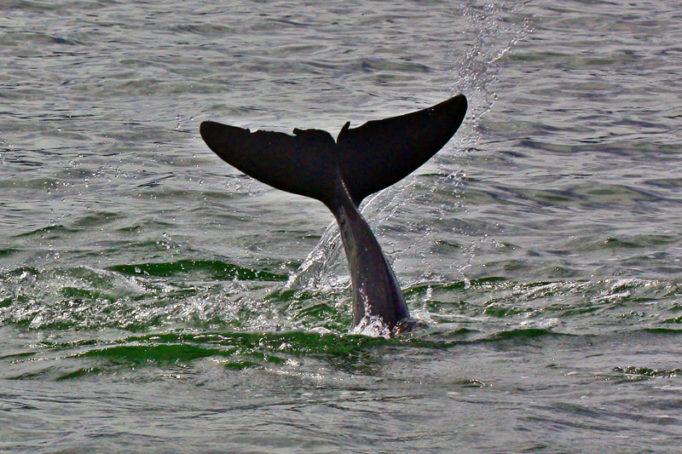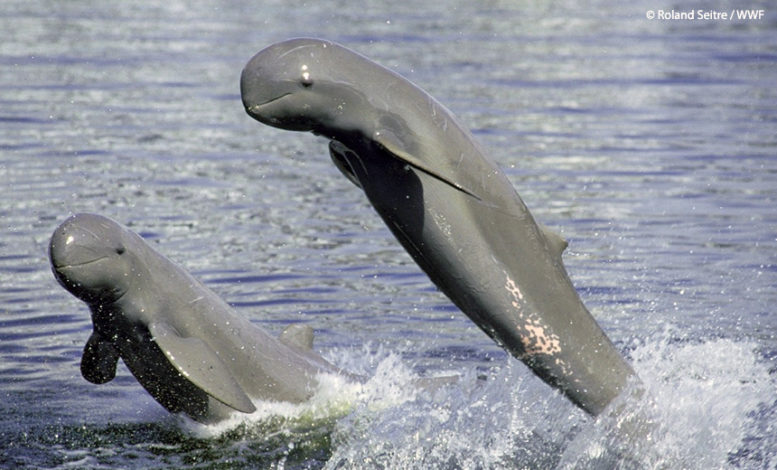The Irrawaddy Dolphin belongs to the scientific family Delphinidae (marine dolphin), and Orcaella brevirostris species. Sir Richard Owen first identified the Irrawaddy Dolphin in 1866.
It lives in shallow tropical and sub-tropical waters near coasts, and at the mouth of rivers or estuaries, land semi-enclosed lakes, bays, sounds and mangroves in Southeast Asian countries like Bangladesh, Cambodia, India, Indonesia, Laos, Malaysia, Myanmar, Philippines, Thailand, and Vietnam. However, its range can reach southern New Guinea and northern Australia. It is not a river dolphin but rather an oceanic dolphin that enters rivers with the ability to adapt to varied levels of salinities, and reside there.
This species has a large rounded melon-head with the indistinct short beak of the Brevirostris. It has a short and blunt triangular dorsal fin, and long and broad flippers. The porpoise is smaller and has flat rectangular teeth. The Irrawaddy Dolphin has 12-19 peg-like teeth on each side of its jaw, and a long mouth-line that gives a “smiling” appearance. At birth, it has a length of about 3.3 feet, and can reach up to 9 feet as an adult. It has a birth weight of about 22 lbs and can weigh up to 440 lbs as an adult, with a lifespan of about 30 years.
Irrawaddy Dophins are slaty blue to slaty gray throughout its back, with a slightly paler underside. They look like Belugas but being an Orcelle (little Orca) genus, they are actually taxonomically closely related to the killer whale, Orca.
The Irrawaddy Dolphin is named after Myanmar’s Ayeyarwaddy River. It is called Pesut in Indonesia; Ph’sout in Cambodia; and Empesut in Malaysia. In the Philippines, it is called Lampasut by Tagbanuas, or Lumba-lumba by Tagalogs and Visayans.
Behavior. The Irrawaddy Dolphin is not so easily spotted because it surfaces in a rolling fashion, and then lifts its fluked tail clear of the water for a deep dive when alarmed. It swims slowly but when chased by motorboats, can swim at 12-16 mph. It likes to spit streams of water from its mouth while spyhopping — a vertical half-rise above water performed to view its surroundings. It can stay submerged up to 12 minutes, and typically dives every 30 seconds to 2 minutes. It does not bow-ride like other dolphins.
The Irrawaddy is rarely solitary. It moves as a group of 2-6 or 10 individuals, but can sometimes congregate to as many as 25 in deep pools. Communication is through clicks, creaks, and buzzes at a dominant frequency of 60 Khz for echolocation. Irrawaddy Dolphins in the waters of Matang, Peninsular Malaysia have a signature frequency of whistles that extends from 3,040 Hz to 17,123 Hz, with low levels of frequency modulation, and different from the whistles of snubfin dolphins or humpback dolphins (Hoffman et al, 2017). The frequency range detectable by the human ear is between 20-20,000 Hz, making the Irrawaddy whistles audible to humans.
In the Ayeyarwaddy and Mekong Rivers, but not in Mahakan, Irrawaddy Dolphins have been documented as participating in cooperative fishing with humans using cast nets by driving the fish towards the fishermen in response to acoustic signals from the dolphins. These methods of working together and recognizing signs has been passed down for generations from father to son and dolphin (female) to calf. The fishermen award the dolphins a share of the catch.
Population. Irrawaddy Dolphins exist in small isolated populations, with a decreasing trend. About 90% of the world’s Irrawaddy Dolphin population occurs in the coastal waters of Bangladesh with 5,832, and at Sundarbans Mangrove Forest with 451; Chilika Lake, India with 134; Malampaya Sound and Quezon in Palawan; and in the coasts of western Visayan Seas, Philippines with 105; Mahakan River, Indonesia with 90; Mekong River Delta along Vietnam, Laos, and Cambodia with 78; Ayeyarwaddy River, Myanmar with 65; Songkhla Lake, Thailand with less than 50.

Malampaya dolphin. Photo credit: Mavic Matillano, WWF
Irrawaddy population in the Philippines. Mavic Matillano, WWF lead Project Officer, said the Irrawaddy Dolphin can be found in Malampaya Sound, Taytay, Palawan (1986); Negros (2005); and Quezon, West Palawan (2013). There are 42 left in Malampaya (Resurrecion, WWF, 2010), and at least 20 in Quezon, western Palawan (Matillano, WWF, 2013). In the western Visayan Seas, there are about 18-23 along the coasts of Bago and Pulupandan, Negros Occidental (de la Paz, Senoron, Sabater, Dolar, 2010); and about 25-30 along the Iloilo and Guimaras Straits (Dolar, 2014).
Reproduction. The Irrawaddy Dolphins reach sexual maturity at 7-9 years of age. In the Northern Hemisphere, mating is reported from December to June (Arnold, 2002). Most calves appear to be born between June-August. Irrawaddy Dolphins in Chilika Lake have a low breeding rate, producing only one calf in 2-3 years, with a gestation period of 14 months (S.K. Sarkar, 2007).
The Irrawaddy Dolphins live on a diet of fish, crustaceans, cephalopods, and fish eggs. In shallow waters, it forages on the sea bed for prawns and octopi.
The IUCN 2016 Red List classifies Orcaella brevirostris as Vulnerable range-wide.
But since 2004, the sub-populations along the freshwater Mekong, Mahakan, and Ayeyarwaddy Rivers as well as those in the brackish Songkhla Lake and Malampaya Sound are listed as Critically Endangered.
Threats. Their sub-population is low with a significant decline in population. The worst threats to the Irrawaddy Dolphins are by-catch and drowning in gillnets, and habitat degradation and loss. These are well documented, and continue to persist.
Other threats include illegal hunting for its oil, aquarium trade, boat strikes, chemical effluents from mining and agricultural fertilizers, electric shock fishing, and blast fishing — using explosives in Malampaya Sound.
The Malampaya sub-population of Irrawaddy Dolphins was first discovered in 1986 (Kataoka et al, 1995), residing in the shallow waters of the inner sound. At that time, they consisted of 77 dolphins. Due to anthropogenic activities, their numbers have dwindled to 47 in 2007, 45 in 2005, and 42 in 2010.
Altogether, these threats cause unsustainable mortality and could result in an estimated 30% reduction in population size over the next 3 generations.
The book Red List Assessment for Marine Mammals by the Marine Wildlife Watch of the Philippines lays out how the Irrawaddy Dolphin would also be vulnerable to exacerbated effects of Climate Change on coastal food prey and habitats that could push it to the brink of extinction.
Conservation. This species enjoys the highest level of international protection. All trade is forbidden under international agreements. But more awareness education for the fishermen is clearly needed because not many of them know that the Irrawaddy Dolphins in the Philippines are close to extinction.
In 2001, the World Wildlife Fund (WWF)-Philippines initiated the Malampaya Sound Research and Conservation Project to sustainably manage Malampaya Sound’s fisheries and protect the Irrawaddy Dolphin population in the area from gillnets and explosives.

Irrawaddy fluked tail. Photo: Care for Dolphins.net
The Irrawaddy Dolphin is now an icon serving as the “umbrella” species to help establish protected coastal areas and estuaries in the Philippines.
In brief, Sections 11 & 97 of the Philippine Fisheries Code (R.A.8550), provide protection:
Section 11 – Protection of Rare, Threatened and Endangered Species. The Department of Agriculure (DA) shall declare closed seasons and take conservation and rehabilitation measures for rare, threatened, endangered species, and ban fishing, taking of rare, threatened, endangered species, including eggs and offspring.
Section 97 – Fishing/Taking of Rare, Threatened, Endangered Species: makes it unlawful to fish or take rare, threatened, endangered species as listed in CITES and DA, and punishable by 12-20 years in prison and/or a fine of P120K, forfeiture of the catch, and cancellation of fishing permit.
The author would like to acknowledge the contribution of Marine Wildlife Watch of the Philippines (BFAR-NFRDI) in sharing the 2013 Red List Assessment for Marine Mammals by M.Alava, M.Dolar, E.Sabater, MTR Aquino, and M.Santos (eds), and information on Irrawaddy Dolphin populations in Malampaya Sound and Quezon, Palawan and Guimaras Strait. Visit www.mwwphilippines.org
